オールドノリタケに見られる我が国固有の芸術の影響
このページでは、オールドノリタケに認められる日本固有のアートの影響を示します。
明治以前の我が国の伝統的な芸術や工芸があったからこそ、
オールドノリタケが生まれ得たわけですので、両者の関連性は当然のことかもしれません。
しかし、縄文時代の荒削りの土器から江戸の浮世絵まで見直してみると、
改めてこの国や日本人の独自性と継続性に誇りを感じてしまいます。
やっぱり、この国が好きです!
そんな気持ちをオールドノリタケ・ファンの皆様と共有したくて、
あえてこのページを公開することにしました。
わがオールド・ノリタケ・ファン・クラブ独自の、まったくオリジナルの提案です。
きっと、さまざまなご意見があると思いますので、
どうぞ遠慮なくメールを下さい。お待ちしております。
This page is very unique and has an origainal opinion by myself
concerning of the Japanese proper traditional art
which had influenced the design and technique of the Nippon/Old Noritake items
To understand the taste of Old Noritake, in particular, items of Nippon,
it is important to know the original Japanese art before the Meiji period (-1868).
In this page, I would like to present several images of Japanese original art as some clues to understand it.
You may feel a strong connection between such origianl art and the Nippon/Old Noritake items.
How do you think?.
Hope you could let me know your opinion with your E-mail when you see this page.
縄文土器 中期縄文時代
Jomon Doki (Fired clay urn)
Middle Jomon period, 4000-2000 BC
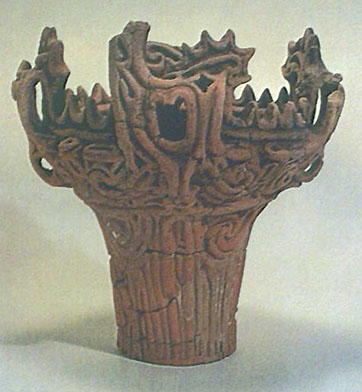 ・
・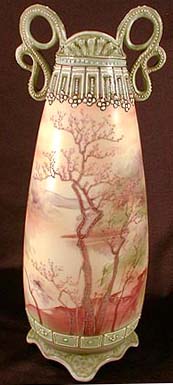
非常にユニークな縄文土器の存在は、我々日本人が中国や朝鮮から、あるいは南洋からの単純な渡来民族でないことを示すひとつの物証と思われる。何千年も昔にこのような土器を作った私たち祖先の感覚は、まことに素晴らしい。このような感覚が引き継がれていない限り、右に示すような装飾をGalleの壺に施すことはできないと私は思う。
The presence of Jomon Doki indicates that the Japanese is not the people who simply imigrated from Oceania or from Continental rout, because this type of pottery is so unique and probably impossible to find similar items in China, Korea, Taiwan, or islands in Pacific Ocean. Unless the artisit of Nippon succeeded the blood from Jomon people, it seems hard to put the decorative handles on the Galle type vase shown on the right panel.
鳥獣戯画 高山寺 平安時代
A set of scrolls, Choju Giga (Frolicking animals)
Heian period, Kozan-Ji Temple, 12th century
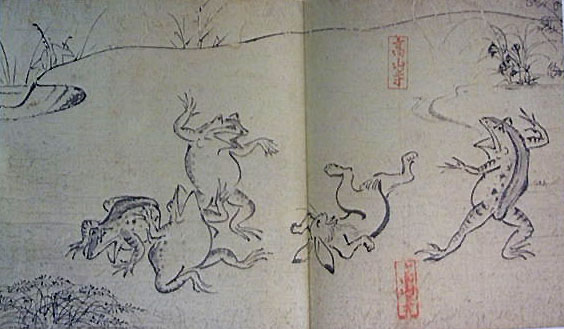 ・
・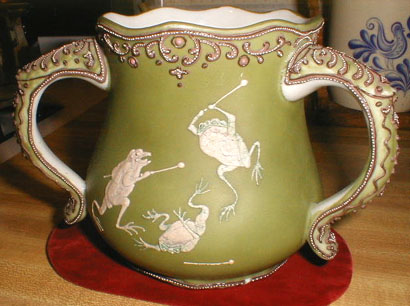
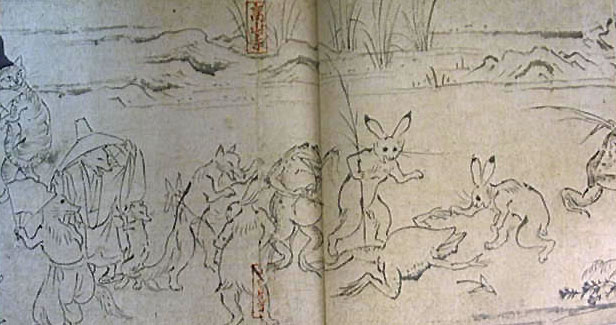 ・
・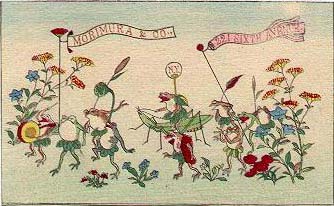
最後の一枚のイラストは、ニューヨークの森村ブラザーズがGreeting cardとして制作した物で、
当時の店舗の住所が入っています。
明らかに鳥獣戯画のコピーと分かります。
This narrative scroll set in the monochrome ink fashion known as Choju Giga has no accompanying text, but it was (is) the work of Buddhist monks. It deals with the subjects of Buddhism in hilarious manner. The first part shows human games and other activities performed by animals often dressed as humans. Some of them are real and some are fantasy animals. In some parts, monks and laymen at play, then animals parodying their actions. The later part might have been made in the 13th century.
Elsewhere in the scrolls, animals who are doing Sumo (Japanese wrestling), riding, picknicking, can be seen. There are lot of the whimsical caricature of humanity. (The art of ink caricature has survived until modern Japanese life where we are now addictive in Manga (Comics) and animations in TV or in many magagines, such as Pokemon, Akira,,, so on)
The colourful illustration is a greeting card of Morimura Brothers Inc in New York. On the right flag, the address of their office, 221 Sixth Avenue, can bee seen. It is probably over 70 years old. Because I do not know well about the history of the Morimura Brothers Inc in NY, in case you could let me know the presice information of this issue, it would be very appreciated.
平治物語絵詞 鎌倉時代
A set of picture handscrolls, Heiji Monogatari E-Kotoba
Kamakura period, Early to mid 13th century
 ・
・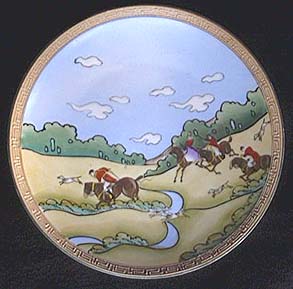
 ・
・
平治物語は、1159年に起きた源氏対平家の政変劇(藤原信頼が企て失敗した入道信西に対するクーデター)を記録したものである。平治物語絵詞もそれを絵画で表したものであり、物語作者の藤原教家による詞書によってそれが語られている。
この時期の絵巻物は、平安時代に比べると仏教思想を背景にしつつも、リアリズムが鮮明になる。美術のパトロンが公家・藤原家から武家・源氏に代わったのだから、当然のことかも知れない。とくに、平治物語絵詞の馬や武具の表現は、他の追随を許さない傑作である。巻物の幅が40センチ以上あるので、作者(住吉慶忍との説もあるが、作者は不明)は戦闘の様子をより生き生きと描くことができたのも一因であろう。西洋の絵画ではこれほどダイナミックに動きが描かれるのは、実にドガが踊り子を描くようになってからである。油絵と水彩絵画の違いが影響していようが、実にさらに600年の時間を要したのである。明治になって、森村の絵付け師たちが軽やかな馬の動きで楽しい狩りの姿を描くことが出来たのも、このような歴史があってのことではないだろうか。
なお、平治物語絵詞の一部はBoston美術館に保存されている。
Patronage for the fine art changed from the courtly Fujiwara to the martial Minamoto, when Minamoto Yoritomo instituted the Bakufu form of government (Samurai's government) in 1185 and in 1192 when the Emperor comfirmed Yoritomo's authority with the title of Shogun (Barbarian-Subduing Supreme Gerenal). From then, many picture handscrolls began to narrate heroism and loyalty of wars and battles. Among many, the set of scrolls, Heiji Monogatari E-Kotoba, which describes the battle in 1159 between the Minamoto (Genji) and Taira (Heike) clans, is the finest one in quality and in technique, and the biggest in size (over 40cm wide). This is based on a same name novel written in 1220. The painter was successful to describe physical realism using a direct and epic manner.
In the paintings of the Western countries, such dynamism only can bee seen from when Edgar Degas (1834-1917, France) painted dancers and singers in the late 19th century (The history of sculpture work was not same). The artists of the Morimura company in the late 19th century to the early 20th century might have been already good at painting of the dynamic physical activities such as hunting scene shown on the right panels.
A part of set of the Heiji Monogatari E-Kotoba has survived as a collection of the Boston Museum in MA.
長谷川等伯の松林図 桃山時代
Pine forest by Hasegawa Tohaku
Momoyama period, Late 16th Century
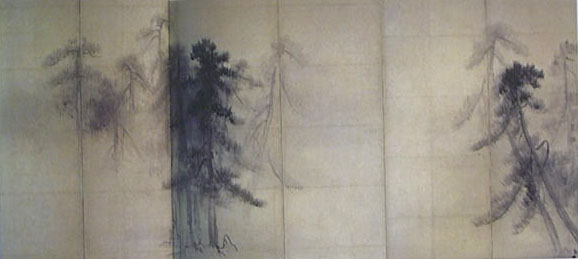 ・
・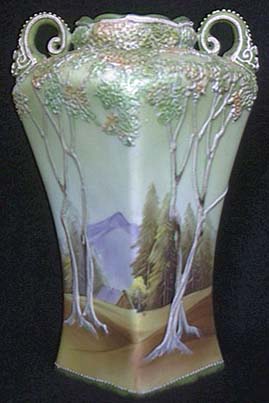
等伯は構図力の優れた画家である。彼の技は完成されたものであったが、彼は一派をなすことなく一代でその命を終えた。彼の代表作は、もちろんこの松林図である。実物は6枚の襖絵である。よく言われることであるが、等伯は画面の10-15%にしか墨を入れていない。残りは空白である。しかし、何ら手を入れていない80%を越える部分で「空気」と「静寂」という雰囲気を表現することに成功した。どの流派にも属さない彼だからこそ完成させることができた傑作である。
俵屋宗達の白像 江戸時代初期
White Elephant by Tawaraya Soutatsu
Early Edo period, Early 17th Century
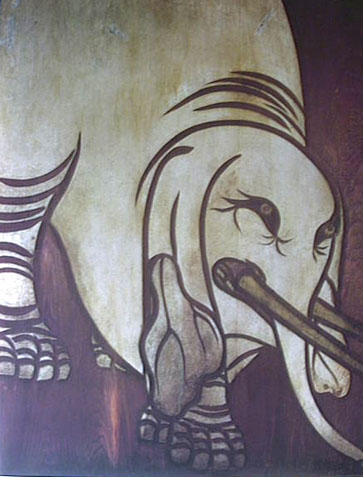 ・
・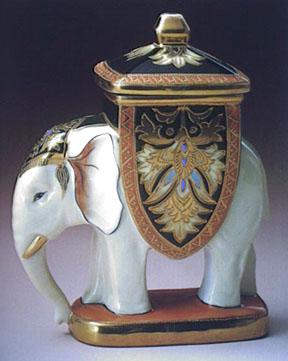
日本に生きた象が初めて来たのは、1408年(応永15年)足利義持に南蛮船から献上された時とされている。人々はその巨大さに驚くとともに、「黒い」象として印象に残ったようである。その後江戸時代・8代将軍吉宗までに生きた象は少なくとも6回は来ている。秀吉や家康もこれらの生きた象を見て楽しんだと言われている。しかし、それ以前から経典や仏画に描かれた普賢菩薩を乗せた白い象のことを人々は知っていた。この経典の影響で、象は白い物という先入観があったからであろう、1408年に来た象は「黒かった」と伝えられている。吉宗も「白い象が見たい」と渇望していたらしい。彼は暴れん坊将軍。外国のことにも大変興味があったようだ。彼の望みに応じて、ついに1728年(享保13年)2匹の象が運ばれてきたが、やはり白象ではなく彼をがっかりさせた。それほど白い象には特別の感情が我々日本人にはあったのかもしれない。宗達が描いた象やノリタケの象のキャンディーボックスが白いことも、決して偶然ではない。
In 1408, an alive elephant was brought to Japan from Southeastern Asia, as a gift to Ashikaga Yoshimochi, a shogun of Muromachi period. That was the first event for Japanese people to see real elephant. People on that time had known the presence of elephant because they were familiar to a white elephant painted on narratives of Buddhism. Until the next three hundred years, at least, alive elephants came to Japan six times. The 8th Shogun of Edo period, Tokugawa Yoshimune, requested a Chinese businessman to bring "white elephants" even though the country Japan was closed in politics and in economy. In 1728, as he wanted, two elephants finally came to Japan and Yoshimune met one of them in Edo(Tokyo). He was glad to see it but unsatisfied because they were not white. These may indicate that for Japanese people in the old days, white elephant had special religeous meaning. Unfortunately, I have no such image of Buddhism illustration, so that let me present you another white elephant which was painted on a wood door of a temple in Kyoto. It is not coincidental that these elephants by Soutatsu and by the Noritake were also white.
尾形光琳の燕子花図 江戸時代中期
Irises by Ogata Korin
Middle Edo period , Early 18th century
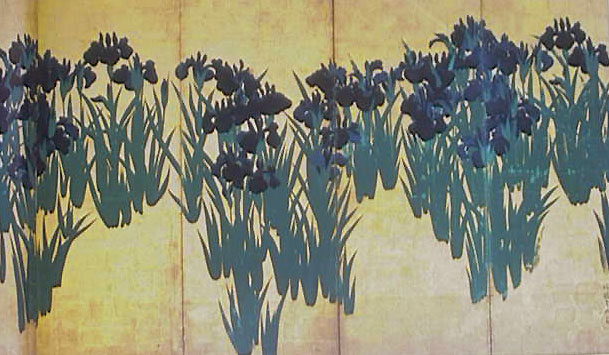 ・
・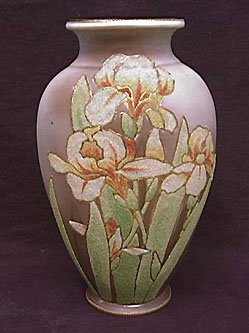
安藤広重 江戸時代後期
Ukiyo-e of Ando Hiroshige
Late Edo period, Mid 19th century
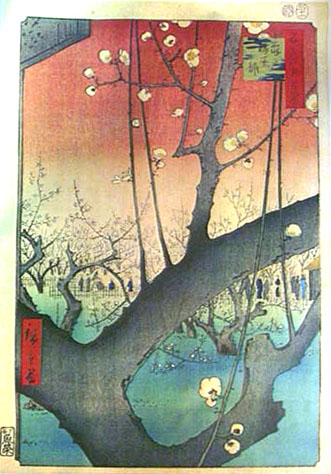 ・
・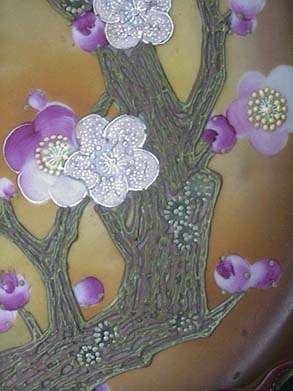
Jomon Doki (Fired clay urn)
Middle Jomon period, 4000-2000 BC
 ・
・
非常にユニークな縄文土器の存在は、我々日本人が中国や朝鮮から、あるいは南洋からの単純な渡来民族でないことを示すひとつの物証と思われる。何千年も昔にこのような土器を作った私たち祖先の感覚は、まことに素晴らしい。このような感覚が引き継がれていない限り、右に示すような装飾をGalleの壺に施すことはできないと私は思う。
The presence of Jomon Doki indicates that the Japanese is not the people who simply imigrated from Oceania or from Continental rout, because this type of pottery is so unique and probably impossible to find similar items in China, Korea, Taiwan, or islands in Pacific Ocean. Unless the artisit of Nippon succeeded the blood from Jomon people, it seems hard to put the decorative handles on the Galle type vase shown on the right panel.
A set of scrolls, Choju Giga (Frolicking animals)
Heian period, Kozan-Ji Temple, 12th century
 ・
・
 ・
・
最後の一枚のイラストは、ニューヨークの森村ブラザーズがGreeting cardとして制作した物で、
当時の店舗の住所が入っています。
明らかに鳥獣戯画のコピーと分かります。
This narrative scroll set in the monochrome ink fashion known as Choju Giga has no accompanying text, but it was (is) the work of Buddhist monks. It deals with the subjects of Buddhism in hilarious manner. The first part shows human games and other activities performed by animals often dressed as humans. Some of them are real and some are fantasy animals. In some parts, monks and laymen at play, then animals parodying their actions. The later part might have been made in the 13th century.
Elsewhere in the scrolls, animals who are doing Sumo (Japanese wrestling), riding, picknicking, can be seen. There are lot of the whimsical caricature of humanity. (The art of ink caricature has survived until modern Japanese life where we are now addictive in Manga (Comics) and animations in TV or in many magagines, such as Pokemon, Akira,,, so on)
The colourful illustration is a greeting card of Morimura Brothers Inc in New York. On the right flag, the address of their office, 221 Sixth Avenue, can bee seen. It is probably over 70 years old. Because I do not know well about the history of the Morimura Brothers Inc in NY, in case you could let me know the presice information of this issue, it would be very appreciated.
A set of picture handscrolls, Heiji Monogatari E-Kotoba
Kamakura period, Early to mid 13th century
 ・
・
 ・
・
平治物語は、1159年に起きた源氏対平家の政変劇(藤原信頼が企て失敗した入道信西に対するクーデター)を記録したものである。平治物語絵詞もそれを絵画で表したものであり、物語作者の藤原教家による詞書によってそれが語られている。
この時期の絵巻物は、平安時代に比べると仏教思想を背景にしつつも、リアリズムが鮮明になる。美術のパトロンが公家・藤原家から武家・源氏に代わったのだから、当然のことかも知れない。とくに、平治物語絵詞の馬や武具の表現は、他の追随を許さない傑作である。巻物の幅が40センチ以上あるので、作者(住吉慶忍との説もあるが、作者は不明)は戦闘の様子をより生き生きと描くことができたのも一因であろう。西洋の絵画ではこれほどダイナミックに動きが描かれるのは、実にドガが踊り子を描くようになってからである。油絵と水彩絵画の違いが影響していようが、実にさらに600年の時間を要したのである。明治になって、森村の絵付け師たちが軽やかな馬の動きで楽しい狩りの姿を描くことが出来たのも、このような歴史があってのことではないだろうか。
なお、平治物語絵詞の一部はBoston美術館に保存されている。
Patronage for the fine art changed from the courtly Fujiwara to the martial Minamoto, when Minamoto Yoritomo instituted the Bakufu form of government (Samurai's government) in 1185 and in 1192 when the Emperor comfirmed Yoritomo's authority with the title of Shogun (Barbarian-Subduing Supreme Gerenal). From then, many picture handscrolls began to narrate heroism and loyalty of wars and battles. Among many, the set of scrolls, Heiji Monogatari E-Kotoba, which describes the battle in 1159 between the Minamoto (Genji) and Taira (Heike) clans, is the finest one in quality and in technique, and the biggest in size (over 40cm wide). This is based on a same name novel written in 1220. The painter was successful to describe physical realism using a direct and epic manner.
In the paintings of the Western countries, such dynamism only can bee seen from when Edgar Degas (1834-1917, France) painted dancers and singers in the late 19th century (The history of sculpture work was not same). The artists of the Morimura company in the late 19th century to the early 20th century might have been already good at painting of the dynamic physical activities such as hunting scene shown on the right panels.
A part of set of the Heiji Monogatari E-Kotoba has survived as a collection of the Boston Museum in MA.
Pine forest by Hasegawa Tohaku
Momoyama period, Late 16th Century
 ・
・
等伯は構図力の優れた画家である。彼の技は完成されたものであったが、彼は一派をなすことなく一代でその命を終えた。彼の代表作は、もちろんこの松林図である。実物は6枚の襖絵である。よく言われることであるが、等伯は画面の10-15%にしか墨を入れていない。残りは空白である。しかし、何ら手を入れていない80%を越える部分で「空気」と「静寂」という雰囲気を表現することに成功した。どの流派にも属さない彼だからこそ完成させることができた傑作である。
White Elephant by Tawaraya Soutatsu
Early Edo period, Early 17th Century
 ・
・
日本に生きた象が初めて来たのは、1408年(応永15年)足利義持に南蛮船から献上された時とされている。人々はその巨大さに驚くとともに、「黒い」象として印象に残ったようである。その後江戸時代・8代将軍吉宗までに生きた象は少なくとも6回は来ている。秀吉や家康もこれらの生きた象を見て楽しんだと言われている。しかし、それ以前から経典や仏画に描かれた普賢菩薩を乗せた白い象のことを人々は知っていた。この経典の影響で、象は白い物という先入観があったからであろう、1408年に来た象は「黒かった」と伝えられている。吉宗も「白い象が見たい」と渇望していたらしい。彼は暴れん坊将軍。外国のことにも大変興味があったようだ。彼の望みに応じて、ついに1728年(享保13年)2匹の象が運ばれてきたが、やはり白象ではなく彼をがっかりさせた。それほど白い象には特別の感情が我々日本人にはあったのかもしれない。宗達が描いた象やノリタケの象のキャンディーボックスが白いことも、決して偶然ではない。
In 1408, an alive elephant was brought to Japan from Southeastern Asia, as a gift to Ashikaga Yoshimochi, a shogun of Muromachi period. That was the first event for Japanese people to see real elephant. People on that time had known the presence of elephant because they were familiar to a white elephant painted on narratives of Buddhism. Until the next three hundred years, at least, alive elephants came to Japan six times. The 8th Shogun of Edo period, Tokugawa Yoshimune, requested a Chinese businessman to bring "white elephants" even though the country Japan was closed in politics and in economy. In 1728, as he wanted, two elephants finally came to Japan and Yoshimune met one of them in Edo(Tokyo). He was glad to see it but unsatisfied because they were not white. These may indicate that for Japanese people in the old days, white elephant had special religeous meaning. Unfortunately, I have no such image of Buddhism illustration, so that let me present you another white elephant which was painted on a wood door of a temple in Kyoto. It is not coincidental that these elephants by Soutatsu and by the Noritake were also white.
Irises by Ogata Korin
Middle Edo period , Early 18th century
 ・
・
Ukiyo-e of Ando Hiroshige
Late Edo period, Mid 19th century
 ・
・
This page has been proposed as my original opinion since December 20th, 2000.
Please have a mail and let me know your idea.
是非、皆様のご意見をお待ちしております。
* * * * * * * * *